| Joan Chen
Remembering Doris Schöttler-Boll
The Innovative Deconstructivist
Artist Died in January 2015
Doris Schöttler-Boll, a German artist born in Nördlingen
but with roots in the Ruhr District (her mother was apparently evacuated
to South Germany at the end of the war) became known since the late 1970s
for her de-constructivist works that she initially described as a result
of photomontage and collage. Since her days as an art student, she was
known for her strong interest in gender issues and her commitment to social
issues, including women's rights. This led, among other things, to a friendship
with Claudia Gehrke, the chief editor of the Konkursbuch who featured her
work in two special issues, issue 12, 1984 on "Women('s)POWER" and issue
20, 1988 on "The Sexual, Women, and Art."
In the late 1960s, Doris Schoettler-Boll lived in Bochum,
Germany where her husband Peter Schöttler was enrolled in the history
department of the Ruhr University. She studied art with Professor Wamper
at the Folkwang Academy (now the Folkwang University of the Arts), and
simultaneously attendeded lectures in Bochum. Her thirst for knowledge
and understanding of intricate contexts, whether in the fields of art,
philosophy, psychology, or sociology, was insatiable. She was also an avid
''cinéaste'' who spent much time seeing art films at the Bochum
university film club. It was here that she encountered Wolfgang Beilenhof,
Sebastian Feldmann, and Andreas Weiland with whom she formed a life-long,
intimate friendship. Others who became important for her were Urs Jaeggi
and Jürgen Link but also the philosopher Jürgen Frese.
In Bochum, Doris became part of a circle of Althusserians
and briefly joined a left-wing party as a student, but was soon excluded
because of her 'radicalism' together with the other members of the circle
that studied and discussed the works of Louis Althusser. Her husband subsequently
became an important translator of Althusser's works and it was with him
that she was to move to Paris later on, though, as her husband notes, she
was not steadily living with him in Paris but moved back and forth, between
France and Germany.
During her student days in Bochum, she also formed friendships
with Gerhard Plumpe, Klaus Krone, Klaus-Michael Bogdal and others that
would matter to her.
After finishing her studies at the Folkwang Academy, Doris
Schöttler-Boll studied at the Düsseldorf Art Academy from 1970
until her graduation in 1974. She was accepted as an art student by Professor
Borbeck but soon was accepted by Joseph Beuys who became her mentor and
who thought highly of her. It was Beuys' free approach to art (and to art
education, seen more as a way of providing an example and an inspiration)
that attracted her, and due to her political engagement (on the left),
it was clear that the man, Beuys, and his practice as well as his concept
of "social sculpture" (soziale Plastik) was bound to fascinate her. Beuys,
in turn wrote that he cherished her lack of aesthetic rigidity and the
way in which she escaped what he called "Politismus" ("politicism") in
her practice as an artist.
During the days as a Düsseldorf Art Academy student,
she organized a rent strike in the big modern tenement house (the 'Girondelle')
where she lived with her husband. She also formed a group of kids from
the 'Girondelle' and motivated them to draw and paint when this little
group of perhaps twenty children of different ages met. Even at that stage,
revolt and le désir coincided. When bringing paper and crayons
or water colors to these (mostly working class) kids, she encouraged the
children to express their wishes and longings visually. Her active involvement
was admired by the Dortmund-based urbanist Peter Zlonicky and her friend,
Andreas, then a young poet who edited a small multilingual poetry
and film mag in Bochum together with Steven Diamant, a student of archaeology
living at the time in Philadelphia. The 'art works' by children that originated
would feature in the first art exhibition she would organize and curate.
With support by Joseph Beuys, the works were exhibited in the art academy.
It was after having just graduated in Düsseldorf
that she embarked on her life-long endeavour as a scot-free, thus independent
artist, scarcely protected economically by the meagre incomes of her young
husband whom she soon joined in Paris. Here, she met with and became friends
with all the people Peter was in professional contact with, Michel Pécheux,
Pierre Macherey, Etienne Balibar, Jacques Derrida, even Althusser. Her
charm, vivacity, her intellectual curiosity, her inventive quests as an
artists drew people close to her. It happened again, when, accompanying
her poet friend, she encountered Danièle Huillet and Jean-Marie
Straub. Intuitively, both recognized the affinity of a soul in her, the
rebel, the artists, the authentic person. What made life in Paris an ambiguous
experience for her, was her lack of talent (or was it time) that hindered
her to learn the language. All the people she would have wanted to engage
in discussions with, night after night, had to resort to their knowledge
of German to carry on a conversation. And if that did not suffice, Peter
had to translate. It was the language barrier that turned her stays in
Paris into short, but repeated visits. Her husband remembers that during
that time, he was quite often alone.
In 1978, Peter Schöttler went to Bremen because of
a job he was offered by the university. And thus, the flat in the 'Girondelle'
was given up and the young artist moved to Bremen. as well, where
she taught at the university, organizing courses focused on "women
and art" and on civil rights issues. The late 1970s were clearly a period
marked by a roll-back strategy in West Germany; it was a reply of the "old
elites" to the euphoric upswing of progressive trends in the arts, literature,
and politics that had set in more or less in the year 1968, or shortly
prior to the events of May in Paris. Those who knew the activities of the
artist in Bremen will remember exhibitions she curated and organized. These
exhibitions were the 'result' of art projects she had realized with her
female students but included also her own work. One of them was titled
''Hair – Or Looking for Traces of the Female'' (Haare, oder Spurensuche
des Weiblichen). Feminist research or should I say, gender issues, were
in the foreground. Another exhibition - related to the aforementioned project
because it also posed questions with regard to 'identity' and put in doubt
the established concepts of identity so dear to the 'authorities' - was
titled ''Photo Albums, Portraits, Mug Shots'' (Photoalbum, Porträtphotographie,
Polizeiphotographie; 1980). The accompanying catalogue was published in
1980 by the university, as part of a series of publications of the Social
Science Department and the Bremen University Library). A similar exhibition,
also dedicated to the analysis of "mug shots" taken by police photographers
and considered "very avant-garde" because of its radical subject, was later
on organized by the Center for Art and Media Karlsruhe (known in Germany
as the ZKM Zentrum für Kunst und Medientechnologie), but by then approximately
two decades had passed. The exhibition focused on "hair" is documented,
by the way, in the catalogue Frauen und Kunst: Dekonstruktion von Frauen/Bildern
durch Collage + Montage (Women and Art: Deconstructing Images of Women
by way of Collage and Montage), published by the Weserburg Museum Bremen
in 1982.
Doris Schöttler-Boll worked as a free-lance artist
and simultaneously held her small job as a teacher of art courses at the
university (a job that she got in 1979) until 1986. It was already in 1984
that she and her husband separated; a divorce followed, and then she was
off to Essen, as an artist in residence housed in a small "chamber" of
Borbeck Castle, with a space to work, and - also very inspiring -
an opportunity to realize a series of beautiful exhibitions.
During this time, artists like Nan Hoover, Timm Ulrich
and Tony Morgan (whom she met thanks to her friend, Andreas) formed warm
friendships with her. They loved her warmth, the cordial and selfless engagement,
her intellectual awareness, and the inspiration revealed in her art works.
She exhibited them all, Nan, Timm, Tony and others whose work she cared
for, like Toto Frima, Eu Nim Ro, Harald Falkenhagen and Norbert Schwontkowski
during the fall and winter of 1987 and in spring, 1988.
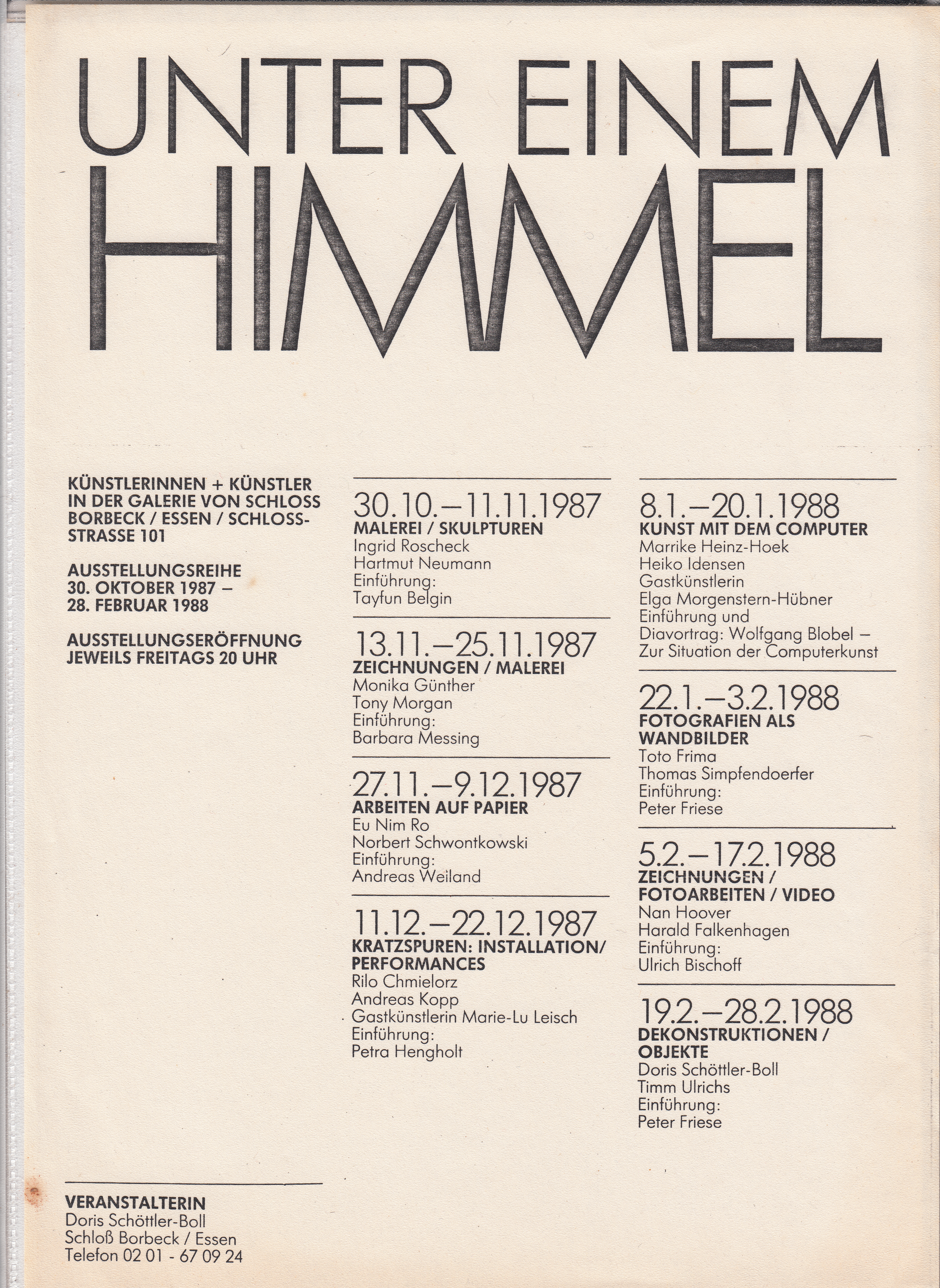
Flyer announcing the long (Oct. 1987 - Feb. 1988) exhibition 'Unter
einem Himmel' in the Galerie von Schloss Borbeck / Gallery of Borbeck Castle,
Essen / Germany that was curated by Doris Schoettler-Boll. (This image
opens very slowly)
In the summer of 1988, when her time as artist
in residence in Borbeck drew to a close, the Atelier-Vergabegremium (a
jury ) of the Museum Folkwang in Essen decided to give Doris Schoettler-Boll
a specific form of support that had been awarded already to HA Schult and
Herbert Lungwitz: a rent-free, timewise unlimited stay in a municipal ‘art
house.’ Schult had been given a space at the former Kaiser Otto School.
Doris Schoettler-Boll was offered a space at the former Pestalozzi School.
This ‘Atelier House' had been a home for the sculptor Lungwitz since the
early 1980s.

The staircase in the 'Atelier house' in Essen-Steele leading up
to the studio and flat of the artist. It was she who smoothed and
painted the walls, window frames, the steps and railing of the stairs.
With an incredible effort, she renovated the completely
run-down rooms on the top floor of the old school, a former apartment of
the school's janitor that had been out of use for years. It became her
studio, and the space where she would live. She turned it into a hospitable,
open space for the public: people with very heterogenous backgrounds -
as she would note joyfully - who would come to attend lectures, see films,
view art exhibitions in her space or in other spaces the large school building
offered for that purpose. Those who were coming to the 'Atelier House'
- and most of those who came, would invariable return - will remember the
night-long debates that followed presentations by artists, poetry readings,
film screenings, and inspiring lectures. It was the atmosphere not of a
hippy commune nor of an elegant 'salon' but something that had very much
its own quality, but that incorporated traces of what you might call an
alternative scene with the seriosity of a university. For her, it was the
'salon of the 20th - or 21st? - century' that she had brought about, also
in memory of and reverence for the feminist writers of the 19th century
who invited intellectual 'giants' to their 'salons.' Running this
'salon' and the events that took place here since Sept. 1999 consumed much
of her time and energy in the last decade of her life. She was thankful
for the support of members of the association that had formed in support
of her and the 'Atelier house' - most notably the Essen-based filmmaker
Erwin Wiemer, and her technical assistent:::::
(who
was also a lively debater).
It was characteristic of her approach
that she did not only attract artists, academics, students, and others
who were already interested in art. People from the 'hood' came - kids,
working people, the old ones she talked to in the street on her way to
the bakery. Often, these people genuinely liked her, and she was happy
when people like the old woman from across the street - certainly no one
with at least a high school education - came quite regularly to attend
lectures and other events. She attracted a group of retired women from
the neighborhood who came once a week in the afternoon for quite some time,
curious about what she did as an artist and eager to see and hear what
was new to them. Likewise, kids as young as 7 or 8 and as old as 14 or
15 came, and together with another woman (wasn't it a librarian?) she got
the kids involved in a book illustration project that had them drawing
and painting regularly in the school garden once a week...
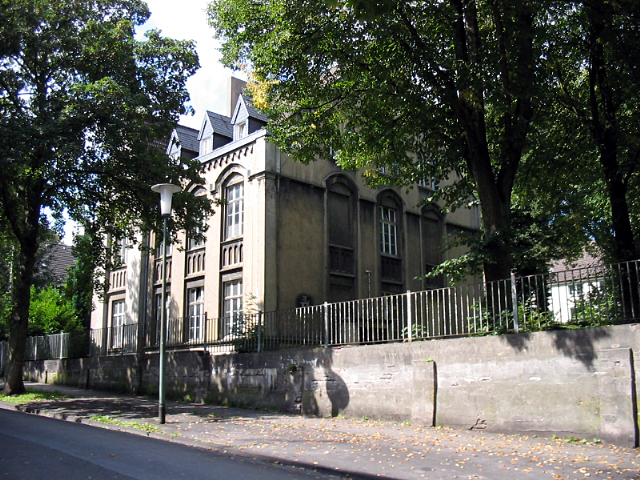
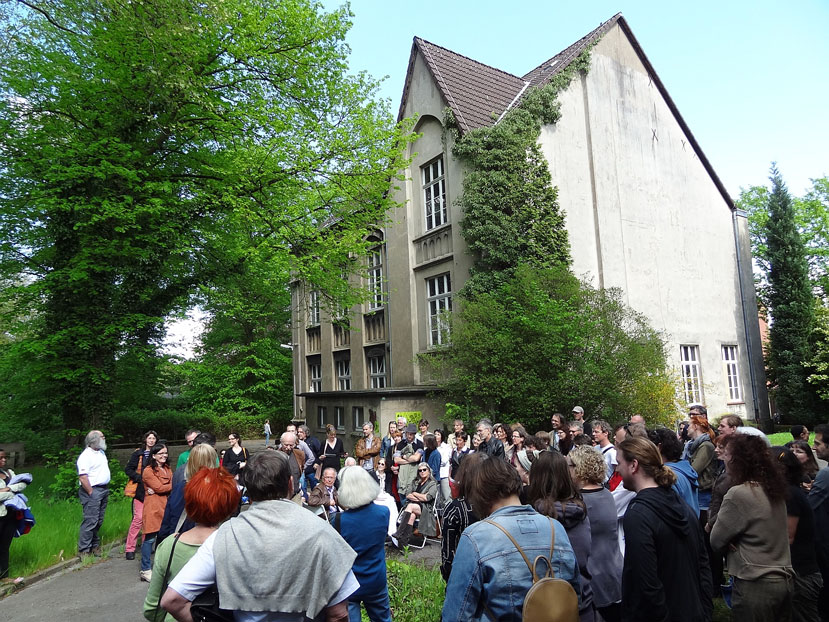
The 'Atelier house' in the Steele quarter of Essen, Germany
The spacious rooms of the school building also provided
an opportunity for such projects of hers as 'Project Green Card' and 'Potentiale'
that aimed to give budding young artists a chance to exhibit their work.
Folks from the neighborhood became committed to save the school when a
department of the city administration signalled a readiness to tear down
the building. It was Doris who was the first who was up on the barricades
- doing meticulous research that showed how the old school was worthy of
protection as a historical monument, a significant part of the local cultural
'patrimony'...
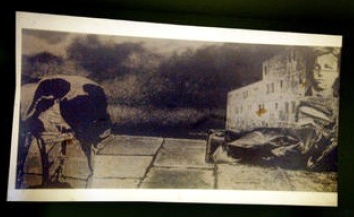
A surrealist atmosphere - sometimes merging with 'scientific'
or with Classical Greek iconography - can be deciphered
in some of Doris Schöttler-Boll's work
The 'Atelier house' became meaningful to her in many ways.
It was here where Harun Farocki, who formed a dear friendship with her,
presented his new projects. Another filmmaker who came was Rainer Komers.
Rainer
Vowe
introduced new films by Godard, but also Rohmer and others that were screened
and debated. Paul Hofmann presented his long-standing
project of a regionally focused film archive. The editor and poet
Dietrich E. Sattler illuminated the public with respect to his life-long
key project, a radically different yet very solid edition of the works
of Hölderlin that challenged traditional
academe. Many artists
came, and of course would not only exhibit their works but debate it with
an enlightened audience. Writers came: Urs Jaeggi, Florian Neuner, Andreas
Weiland and many others, in order to read from and discuss their work.
Jürgen Frese talked about art from a philosophical point of view.
Gerhard Plumpe gave talks, Jürgen Link debated concepts peculiar to
his approach with regard to "discourse theory." Vibrant young experts,
often professors, from art institutes and museums presented finding of
their research on relevant contemporary art and artists.
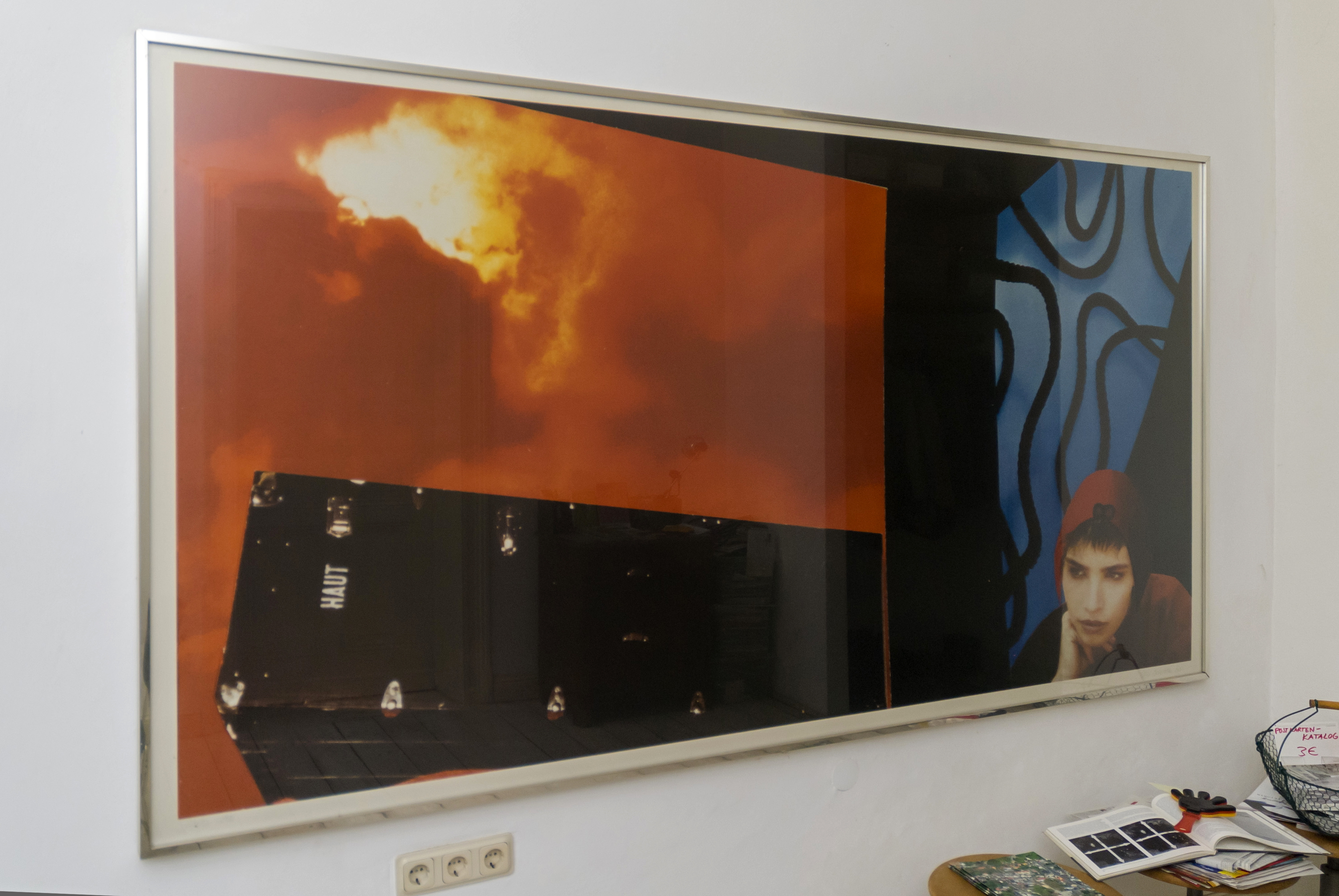
Doris Schöttler-Boll, 'Haut', photo-collage/montage (date:
20...?): The French word 'haut' (upside)
stamped on a suitcase evokes memories of the time when human beings
were detained in France and
shipped to death camps in Germany, Poland and other countries. The
fiery red sky reminds me of the
apocalypse, the ovens. The girl in the lower right corner wears
something like the red cap of French
Jacobins. She seems lonely, sad, pensive - cowering behind bars
of a small window that keeps out
the blue sky.
Though she continued to create inspiring works, thus for
the foyer of the Grillo theater in Essen that was renovated by the well-known
architect Werner Ruhnau, the last years of Doris Schöttler-Boll in
Essen were dedicated increasingly to activities that took the "expanded
concept of art" formulated by Joseph Beuys seriously. To grow, to search
and learn, and to enlighten others mattered to her more than adding continually
new works to her oeuvre. To resists tendencies like the increasing
infantilization and functional illiteracy of growing parts of the population
mattered. The tendencies of de-solidarization and fragmentation of German
society worried her. It made her put in more energy into her activities
subsumed under the title "Persons - Projects - Perspectives."
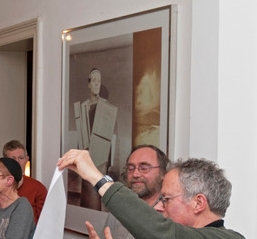
A male figure, almost like a Greek god, seemed to shield himself
with a number of x-ray photos. The right part of the work serially
arranges images of an enigmatic fire.
It is true that her decreasing apparent (that is to say,
'published') production of visual works in her later years also reflected
the steep prices charged by laboratories that produced small editions,
often just one copy, of her usually pretty large-sized works. Often, she
simply did not have the money to pay new editions. Sales were minimal,
despite and perhaps also because of the quality of her collages/montages.
Her art works, though appreciated by art critics, art historians, museum
people, poets, and philosophers, did not find a "market." Even at
the time when she had major solo exhibitions, art galleries and the affluent
shunned her works. It was, as far as I know. writers who loved and bought
what she created, and often the intake was hardly sufficient to finance
projects dear to her. The city of Essen supported her projects that addressed
the public, such as 'Persons - Projects - Perspectives,' regularly
- but with a very modest sum. In return she gave works to the city and,
I think, the museum - as she had done already in Bremen. She got commissions
from public authorities like the one for the Grillo Theater.
Those who knew her intimately were aware that the conflicts
with parts of the bureaucracy of the city of Essen that had made her spend
so much energy, hard manual work, and much of her intake as an artists
on the renovation of her premises in the 'Atelier House', stressed
her immensely. It was the cultural bureaucracy, above all the head
of the art section, Oliver Scheidt, who supported her, something also true
of his successor and of museum people like Sepp Hiekisch-Picard and
Peter Spielmann of the Museum in the neighboring city of Bochum.
Still, the damocles sword of being evicted without compensation for her
effort was what she took for a dark and ominous reality. Her poet friend
mentioned recently that he sees a connection between the long years of
living with the stress of being evicted and the fact that she had to undergo
an operation, due to breast cancer, some time ago. And that finally, lung
cancer led to a premature death. It may be a naive suggestion, he said.
But then adds, American Indians claim that cancer was unknown among them,
as long as they lived fairly stress-free lives. It may be an idea that
is insupportable, in the eyes of modern medical scientists. And yet, the
fact that she was living in extreme poverty, and with the continuous thought
that the city could make her homeless any minute, affected her psyche and
perhaps even her artistic creativity in her last few years. Sometimes she
would explode in anger, in private - or talk of being ready to take her
life. But when guest artists and writers came to present their work to
the public, she was as lively, good-spirited, intellectually awake, and
polite as ever. No, she would not succumb to those who threatened the existence
of the 'Atelier house.' A rebel always, she resisted, to the last
minute. Christa Weltermann und Margarete Lavier saw her regularly during
her last few weeks and days and were faithfully with her when she died.
|




